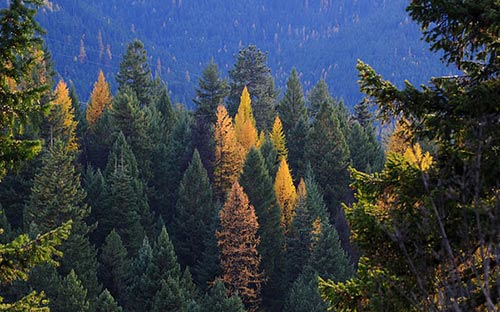Big, bigger, biggest. It’s no surprise that here at American Forests, the headquarters of the National Big Tree Program, we have big trees and champion trees on the brain quite a bit. But we’re not the only ones. People take a lot of pride in their local big trees, and big trees make for quite a story.
We recently heard about a very special, very big tamarack (Larix laricina, also known as an American larch) in Nashua, N.H., that’s been generating a lot of local buzz. Local resident Tracy Pappas told NewHampshire.com, “Not that long ago, the neighborhood thought we would have to save up money to tear down that tree,” explaining, “At certain times of the year, the tree looks dead.”
That’s because tamaracks are one of few softwoods to drop their needles in the winter, after they turn yellow in the fall, just like a hardwood’s leaves. Residents that were unfamiliar with the species mistook the yearly transformation for illness.
That is, until it was nominated for the New Hampshire Big Tree Program. It was nominated by Kevin Martin, a big tree enthusiast who’s working on a book about big New Hampshire trees. Martin tells NewHampshire.com he hopes the book will help people recognize and identify native tree species to avoid such confusion. Ultimately, what seems at first glance like a friendly competition among trees is really about education.
It’s a goal that aligns with the goal of the National Big Tree Program. Preserving and promoting the iconic stature of notable big trees helps to educate people about the key role that trees and forests play in sustaining a healthy environment. By helping people become familiar with different species, the national and state big tree programs are also helping to ensure that residents are more aware of whether a tree is healthy or not.
Now, for the question on everyone’s mind: Does this tree have anything else in common with national champions? Like say, its size? The Nashua tamarack is 79 feet tall with a circumference of 118 inches and a crown spread of 56 feet, giving it a total of 212 points. That’s not too far behind the 219 points the current national champion in Minnesota claims. Could national recognition be in this tree’s future? Only time will tell.
Luckily, when it comes to new national champions, the wait is never too long. The National Register of Big Trees is updated each fall and spring, but applications are accepted on a rolling basis. So, get out and get measuring! If you’ve never measured a tree before, check out our measuring guidelines to find how you can measure a nominee with just a ruler and a string or tape measure. And don’t forget to snap a picture of your friendly giant. Happy hunting!

